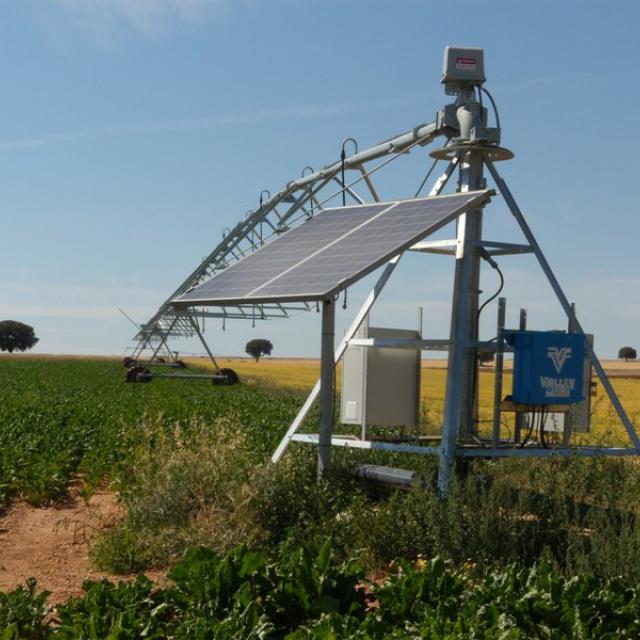We arrived in Cramchaban, in Poitou Charente, between Niort and La Rochelle, where thirty or so farmers from the Landes, installers and technicians attended the presentation of the first solarpivot in France by the Billaud-Segeba dealer, who distribute the Valley® products in Poitou.

Thierry Joubert, a farmer from Cramchaban, near Mauzé/Le Mignon, has owned a solar pivot since last year. His farm covers 150 hectares, including 80 hectares of maize (corn). The cropping plan also includes common wheat, durum wheat, malting barley and oil seed rape. All of his land can be irrigated, except for 7 hectares. However, in this Poitou-Charente region, water is often quite scarce. Thierry Joubert has solved this problem by building a reservoir with a capacity of 350,000 m3, topped up from a borehole. Four farmers draw water from this reservoir, Mr. Joubert has a quota to withdraw 130,000 m3. It takes a month and a half for the reservoir to fill up when it rains. According to our farmer, “within 5 years, there won’t be any water for irrigation if you haven’t got a reserve of water on the farm”, bearing in mind the pressures on the environment.
“within 5 years, there won’t be any water for irrigation if you haven’t got a reserve of water on the farm”, bearing in mind the pressures on the environment.
Solar pivots have already been in use in Spain, for two years now. This one is the first solar pivot used in France. This high-technology tool irrigates a 12-hectare field of maize. A solid set irrigation system was previously used on the field. Water consumption was far higher and irrigation efficiency was poor. Nowadays, there are no underground electric cables, and thus there are no electricity bills to pay… “The savings on water, labour and energy are quite considerable and soon help to offset the high price paid for the pivot”, explains Mr. Joubert.
The pivot is provided with a control box and, of course, solar panels. The control box allows the operator to programme the irrigation sectors and the alignment between towers. It does not have a timer (to programme the start of irrigation). This is an option that the client can request. Mr. Joubert has not opted for this accessory ; he prefers to start the system manually or remotely via the telephone.
The pivot has a GPS-driven monitoring and control system, which sends text messages to the user’s telephone, allowing Mr. Joubert to be informed in real time about the way the pivot is working. For example, if something stops, it restarts the pivot, or if the pivot is shut down safely, then the farmer is duly informed via a text message on his mobile phone.
“The savings on water, labour and energy are quite considerable and soon help to offset the high price paid for the pivot”
he pivot is also equipped with an anti-theft system, which sends a warning to Mr. Joubert on his mobile phone and to his email address. Another possible option is to work with soil moisture sensors. The farmer can then check the soil moisture content on the Internet and, depending on the results, he can then decide on whether or not to irrigate. However, it is always up to the farmer to decide on when to start irrigating, as this is not automatic, because the software can never replace the intelligence and know-how of the user.
Thierry Joubert has had his pivot since autumn 2011. His season is very well planned: he spreads 30 tonnes of composted poultry manure in the autumn. This natural compost is used to enrich the soil in the maize fields. The farmer leaves the manure to decompose in the corner of the field for several months before it is spread on the land.
Tilling and ploughing then begins in December, followed by the rollers in March and the rotary (power) harrows, which prepares the seed bed by breaking up the clods of earth.
Finally, sowing or seeding begins. He does not use fertigation, as the fertiliser is spread on to the land. In the summer, Mr. Joubert applies one full irrigated circle with the pivot per week, which corresponds to 25 mm in 30 hours on our 12-hectare field. “Since the beginning of the season, I have only applied 70 mm as there was a lot of rain in the spring and early summer”.
Thierry Joubert is very happy with his solar pivot, given the savings that he is able to make on water, labour and energy: “I would use it wherever and whenever I can”, he explains to the group of visitors. “The only problem is that such a machine needs 50 years to pay for itself”.
